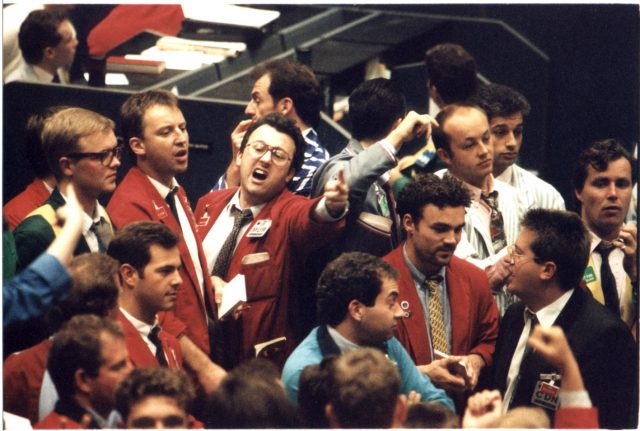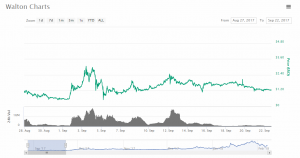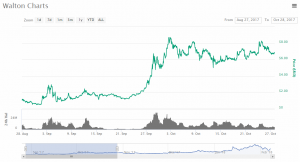
How Investing In INS Now Could Make You Rich In The Next Months

While the current bear market managed to install ‘fear’ on digital asset holders about the future of cryptocurrencies, a big portion of new and old investors are trying to figure out which token is going to be the next Bitcoin and take advantage of the recent price drop in almost every known coin or token that uses distributed ledger technology (DLT). There are hundreds of possible candidates for that spot but today we’re focusing on one single blockchain based platform that is most likely to see significant growth in the next couple of years and further. That would be INS Ecosystem (INS), for various reasons we’re going to analyze in this article.
Before we dive into INS itself, we have to create an analogy of the platform in order to understand and compare historical events on the chart. For that reason, we’ve chosen Walton (WTC) to help us analyze what is going to happen with INS in the next months. Both projects have a similar token supply, they experienced a similar ICO and launching and they are both targeting major consumer-focused industrial sectors.
INS Ecosystem’s native token has a fixed total token supply of 50,000,000 INS, while Walton’s current total supply of WTC is 70,000,000 units. From these, ~28,000,000 make the circulating supply of INS and ~24,000,000 respectively the circulating supply of WTC. INS hit the markets after a successful ICO on January 15th, 2018, as for Walton, which started on September 1st of the previous year, WTC has been bartering in major cryptocurrency exchanges for the last months already and we can get a basic idea of where it’s heading, where it came from and what happened during the period in-between.


We can see from both initial charts, that INS and Walton have a very similar pattern after the ICO. First investors got in, the project hits the markets and they sell their positions with an x3 to x10 profit depending on the timing. That is a common spike everytime a new asset hits public exchange markets.

Now, INS might be young but observing Walton’s path we can do assumptions about where INS’s price per unit could be in the next months. That is Walton’s (WTC) chart given an extra month compared to where INS is now. The previous set of charts was pretty similar, right? How about now? Do you see anything missing from the INS chart compared to WTC’s chart just a month later from where INS is at the moment? Exactly, that huge spike is yet to make an appearance on the INS chart.
INS started during a rough period for the cryptocurrency market, it was the first ‘bloodbath’ of the year and no one was paying attention to new projects popping out in early 2018. The first investors sold their stakes and managed to triple their money at least. Now after the consolidation, we are waiting for the first big wave of new and old investors into the INS Ecosystem, where it’s chart is going to be similar to the previous Walton (WTC) chart in the next month alone.
To be accurate, Walton needed to reach $1 bn in total market capitalization in order to have a price of $40 per WTC. INS will require a slightly bigger market cap in order to reach that price due to the higher volume of circulating tokens. Currently, Walton is at $557 mil market cap and $22 is the price per WTC. INS is at $62 mil market cap and one INS would cost around $2 at the moment.
Let’s take a look at Walton’s current chart and try to make a sense of INS’ potential to reach these numbers in the next months.

INS and WTC may have a pretty similar history up until now, but there are significant differences between the two projects defining the future of INS to be slightly brighter than that of Walton’s for several reasons. Walton has a specific target group around a specific industry, while INS is the first decentralized worldwide grocery. Walton had to face blockchain related problems of 2017, while things might be quite easier for INS as from this year and beyond. Walton is backed by individual investors who are undoubtedly among the biggest players of the Asian markets and have experience and connections in the field, but INS is backed by Goldman Sachs, IBM, Wings, and the largest Russian grocery distributor company to name a few.
For these reasons and more we believe that INS has the potential to disrupt the blockchain based scene and attract monetary attention from both individual investors as well as from corporate modules that can see it’s potential already. After just the first wave of investors, it is most likely that we’re not going to see INS’ price below $5 ever again.
We know that it’s a good time to buy almost anything you might name so I won’t say that INS is a better option to invest in, rather than any other coin. Personally, I would invest carefully in projects that are here to solve real-life problems using blockchain technology and INS is definitely one of them. Let me know your thoughts on this in the comments below.
Reporting for The Independent Republic, Ross Peili